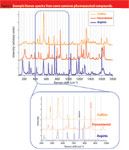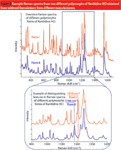News
Article
Pharmaceutical Technology Europe
Pharmaceutical Technology Europe
Raman Spectroscopy for Pharma. Part 1: Principles and Applications
Author(s):
Detection and identification of different polymorphic forms is, therefore, important throughout the drug development and manufacturing process.
Until recently, Raman spectroscopy was not widely applied in the pharmaceutical industry. However, in the last few years, developments within the pharmaceutical industry, coupled with improvements in Raman instrumentation, have generated renewed interest in the technique. It is already proving to be a valuable tool in the analysis of pharmaceutical polymorphs and now looks destined to find increasing application throughout the pharmaceutical industry.
After 80 years of maturing in academic laboratories around the world, Raman spectroscopy has finally begun to make a significant impact in the industrial environment, finding particular application in the semiconductor, chemical and synthetic polymer industries. While still not as widely employed in the pharmaceutical industry as its cousins, near- and mid-infrared (IR) absorption spectroscopies, it has recently found a particular niche in the analysis of pharmaceutical polymorphs. Raman spectra have proved highly characteristic of different polymorphic forms of pharmaceutical compounds and the ability to obtain spectra without the need for potentially polymorph changing sample preparation has proved ideal for applications from polymorph screening to patent litigation. This high profile application of Raman spectroscopy has lead to greater acceptance of, and interest in, the technique within the pharmaceutical industry. With the advent of the US Food Drug Administration's (FDA) process analytical technology (PAT) initiative, Raman spectroscopy is increasingly being considered for applications in the pharmaceutical manufacturing environment.
So that a reader unfamiliar with Raman spectroscopy can begin to determine its suitability to their own particular application, the basic principles and features of the technique are outlined with particular reference to practical application in a pharmaceutical environment. Comparisons are made with IR spectroscopy with which the reader may be more familiar. Some example applications are presented including the detection and identification of pharmaceutical polymorphs. The potential of the technique as a PAT tool will be discussed separately in Part II.
Key Principals and Practical Features
A large body of excellent literature exists documenting the basic theory and practical application of Raman spectroscopy, some of which are recommended.
1-5
The essential features of the technique are, however, outlined here for the benefit of those readers unfamiliar with the technique.
Raman spectroscopy is a form of vibrational spectroscopy and as such is related to near- and mid-IR absorption spectroscopy.6 Similar to the IR absorption techniques, Raman spectroscopy measures the vibrational frequencies of various parts of a molecule. These frequencies depend on both the bond strength and mass of the bound atoms as well as other factors such as intermolecular interactions. The 'pattern' of vibrational frequencies from a molecule is, therefore, highly characteristic of a given molecular species and, for solid samples, of the crystalline arrangement of those molecules. Raman spectra may be readily recorded from gasses, liquids and solids.

Figure 1 Schematic overview of the basic experimental arrangement to perform Raman spectroscopy.
While IR spectroscopy is essentially based on illuminating the sample with a broad range of wavelengths of IR light and measuring which are absorbed, a Raman spectrum is obtained by illuminating the sample with a single wavelength of light from a laser and collecting and analysing the resulting scattered light (Figure 1). Briefly, the basic experimental arrangement to perform Raman spectroscopy includes the following steps:
- To obtain a Raman spectrum the sample is illuminated with light from a laser.
- The molecules in the sample 'scatter' the incident laser light. Some of this scattered light contains detailed information about the molecular properties of the sample.
- The scattered light is collected and analysed using a Raman spectrometer to produce a Raman spectrum.
- Raman spectra are generally clear, well resolved and rich in features facilitating detailed and unambiguous interpretation.
- The spectra contain large amounts of information about chemical composition, intra- and intermolecular phenomena, and the longer range structure of a sample.
The wavelength of the exciting light can lie anywhere from the ultraviolet (UV) to the near-IR ([NIR] with the choice of wavelength used being determined by the details of the application). When the scattered light is collected and spectrally analysed it is observed that a relatively large amount of light is scattered at the wavelength of the incident light; this is known as Rayleigh scattered light and in practice is filtered out and discarded. In addition to this, much smaller amounts of scattered light are observed at various wavelengths shifted with respect to the exciting wavelength; this is the Raman scattered light. Closer inspection reveals that the wavelength difference between the exciting light and each of the various components of the scattered light, when converted to units of frequency, corresponds to the frequency of the molecular vibration giving rise to the scattering.
Another key difference between Raman spectroscopy and its IR cousins is that although all the techniques measure the vibrational frequencies of a molecule, the fundamental physical process giving rise to the effects is different. In practice this means that while some molecular vibrations may be observed in both the IR and the Raman spectra, often vibrations observed using one technique will be extremely weak or totally absent in the other. This complimentary nature can have practical consequences. For example, the IR absorption spectrum of water has very strong features corresponding to the O-H bending vibration (frequency ~1655 cm-1) and the O-H stretch vibration (frequency 3500 cm-1), which tend to obscure the features from other compounds that may be present in solution or in a slurry. By contrast, the Raman signal from water is very weak making the technique particularly suitable for measurements from aqueous samples.
An important feature of the Raman effect is its low efficiency and the consequent very low intensity of scattered light; for every 106–108 photons incident on the sample, typically only one Raman scattered photon is produced. This has a range of practical implications ranging from problems as a result of fluorescent interference from the sample to the requirement for sensitive, low noise detectors.
The features in the Raman spectrum corresponding to the various vibrational modes of a molecule are generally sharp, well resolved and, for many active pharmaceutical compounds, numerous. This is well demonstrated in Figure 2, which compares the spectra of a number of common pharmaceutical compounds. In this example, it is worth noting the large number of sharp, well-resolved peaks and the many differences between the spectra. Spectra were obtained using a Renishaw Raman microscope with 785 nm excitation and 10 s exposure time. A zoomed in view of the 400–1000 cm-1 region of the spectrum is shown. Example characteristic features for each of the spectra are highlighted.

Figure 2 Example Raman spectra from some common pharmaceutical compounds.
Instrumentation. The instrumentation required to perform Raman spectroscopy is, in principal, relatively straightforward. The instrumental details will depend entirely on the functional specification of the instrument, but typical components are described.
Laser excitation. The sample is illuminated with a laser of a suitable power, wavelength and stability. Examples commonly employed in modern instrumentation include diode pumped solid state lasers (most often 1064 nm and 532 nm, but many other wavelengths are available) and stabilized NIR diode lasers (typically ~780–820 nm) operating at powers of a few tens of mW to ~1 W. These lasers are generally compact, reasonably robust and reliable.
Delivery of excitation to sample. The exciting laser light may be delivered to the sample either via a conventional optical system of mirrors and lenses, or via fibre optic cables, which may extend many tens of meters (note that this is not possible with mid-IR absorption spectroscopy because of absorption in the optical fibre). A lens system focusses the exciting light onto or into the sample and collects the resulting Raman scattered light. It is common to couple lab-based Raman spectrometers to optical microscopes so that delivery and collection of light are performed by a high numerical aperture objective. In this arrangement a micrometer sized sampling volume may be achieved, which is particularly suitable for obtaining spectra from small samples, samples embedded in a matrix or to produce high spatial resolution 'Raman maps' such as that shown in Figure 3. Here, the tablet was sectioned using a microtome to reveal the core. An array of Raman spectra was recorded at 13 μm intervals from a 1.5 mm2 area on the sectioned surface of the tablet. The sampling volume for each spectrum was ~5 mm3 and the exposure time for each spectrum was 5 s. Some examples of the recorded Raman spectra are shown. The instrument software was then used to look for characteristic features in the recorded spectra and thus, determine the identity of the material at each point. This information was then used to generate the colour coded map illustrating the distribution of each of the tablet ingredients. It is worth noting that much smaller sampling volumes are possible (by an order of magnitude) with Raman spectroscopy than with IR spectroscopy as a result of the shorter excitation wavelengths used (giving a smaller diffraction limited spot) and because of the fact that all the collimated light emitted by a laser radiation can be readily focussed to an intense diffraction limited spot. This is not the case with traditional, nonsynchrotron IR sources.

Figure 3 Example Raman map of tablet core showing the distribution of APIs and the principal excipient.
Collecting and filtering the scattered light. Efficient collection of the scattered light is essential in Raman spectroscopy because of the weakness of the effect. The collection optics must, therefore, be positioned as close to the sample as possible and have as large an aperture as possible to give a large collection angle (i.e., large numerical aperture collection optics should be used). The collected scattered light must then be spectrally filtered to remove the Rayleigh scattered component otherwise this would swamp the Raman signal. Various types of optical narrow band rejection or edge filters are available to perform this function.
Spectral analysis. The collected Raman light must then be spectrally analysed. This may be done using a low stray light, dispersive spectrometer, with a bandpass filter arrangement or a Fourier transform (FT) type spectrometer. A dispersive spectrometer is generally preferred for excitation wavelengths from the UV to ~820 nm while an FT system is generally required for excitation wavelengths at longer than ~820 nm (e.g., 1064 nm Nd:YAG).7
Detectors. A sensitive, low noise detector is required to detect the Raman scattered light. For UV-NIR excitation slow scan, cooled charged couple device (CCD) cameras are the detector of choice. Such a detector will, however, typically represent the single most costly component of a Raman system. For some applications it may be possible to employ a point detector or a simple array detector which, while providing only very limited spectral information, will be much less expensive. Array detectors suitable for Raman spectroscopy with IR excitation wavelengths have until recently been prohibitively expensive and so a single element detector coupled to an FT spectrometer is generally used.7 These, however, are less sensitive than a system comprising a good dispersive spectrometer and a cooled CCD detector. Recent developments in indium phosphide/indium gallium arsenide phosphide array detectors, however, show promise for IR excited Raman spectroscopy.8
Integrated instruments. The way in which the various components are combined to build a Raman spectroscopic system is critical to the ultimate performance of the instrument. Careful design is required to ensure system reliability, stability and robustness — parameters of vital importance for operation in an industrial environment.
Software. The details of the instrument control and data analysis software will be application dependent. Various proprietary software packages are available that provide a basic interface and often quite sophisticated data analysis facilities coupled with facilities to control instrumentation and tailor the software to an individual application. Increasingly, Raman instrument manufacturers are developing software tailored to the needs of the pharmaceutical industry.
Other features. Various other features may be required of a Raman system when used in specific applications. For example, when operating in a regulatory environment, automated system performance validation to suitable standards and handling of the data (e.g., compliance with 21 CFR Part 11) are desirable. Instrument robustness, stability and good technical support provided by the manufacturer are important for 'mission critical' applications.
Sources of Raman instrumentation. There are a number of established manufacturers of Raman instrumentation.9 These offer a range of different instruments targeted at different applications including Raman microscopes and instruments designed for industrial and manufacturing applications. Alternatively, a number of companies exist that will design and build custom instrumentation optimized for a particular application.
Pharmaceutical Applications
Polymorph detection and identification.
A given solid state pharmaceutical compound can often have different polymorphic forms. This can affect the ease of manufacture, efficacy and stability of the final formulation. Detection and identification of different polymorphic forms is, therefore, important throughout the drug development and manufacturing process, for example:
- During the drug discovery/development process so that the optimum form for eventual manufacture can be selected. Analytical identification of this form will be an integral part in its patent protection.
- During scale up and manufacture it is important to monitor the material being produced to ensure the drug is of the correct polymorphic form for inclusion in the final product.
Once at market, it may be desirable to determine the form of a competitor's material to help establish whether any patent infringement has occurred.
The molecules in different polymorphs experience different intermolecular forces resulting in modifications of both the frequency and intensity of some of the modes of vibration observed in the Raman spectrum. In practice, Raman spectra have proven to be very sensitive to the polymorphic form of a material with often substantial spectral differences evident between polymorphs. The sharp, well resolved features typical of pharmaceutical compound spectra also facilitate the identification of more subtle spectral differences which may, for example, indicate the presence of low levels of one polymorph within another.
In the Ranitidine spectra shown in Figure 4 there are more than 40 clearly resolved peaks in the limited spectral range shown. A zoomed in view of the 900–1400 cm-1 region is shown and example characteristic features highlighted for each of the polymorphs.

Figure 4 Example Raman spectra from two different polymorphs of Ranitidine HCl obtained from tableted formulations from different manufacturers.
Note the large number of sharp, well-resolved peaks and the large number of differences between the two forms demonstrating the ability of Raman spectroscopy to unambiguously discriminate between and identify different polymorphs of the same material. The highlighted characteristic features for each polymorph do not overlap and would thus be potentially well suited to use in a univariate calibration model for the quantitative analysis of mixed samples.
The spectra were recorded with a Renishaw Raman microscope with 785 nm excitation and 15 s exposure. The sensitivity of Raman spectroscopy to polymorphic form has been demonstrated for a number of pharmaceutical compounds.10-18
Identity verification of raw materials. The absence of the need for sample preparation and short spectral acquisition times makes Raman spectroscopy particularly suitable for high throughput identity verification of raw materials. The facility to record spectra through optically transparent containers/windows gives the potential to test materials without opening their containers or in-line as they are fed into the production line.
Homogeneity of mixing in tablets. The high spatial resolution (small sampling volume) available when a Raman spectrometer is coupled to an optical microscope enables chemically specific spectral maps of tablet cross sections to be generated.16, 18 These can typically have a spatial resolution of ~0.5–2 μm and the highly characteristic, well resolved nature of Raman spectra enables the simultaneous mapping of several ingredients. An example Raman map of a commercially available analgesic formulation is shown in Figure 3. The spatial distribution of the three active pharmaceutical ingredients and the principal excipient is clearly revealed. These measurements are straightforward to perform and can give information about the homogeneity of mixing on a micron length scale.
Contaminant identification and cleaning verification. The high spatial resolution of a Raman microscope makes it particularly useful for identifying small particulates such as contamination within formulated products or on swabs as part of cleaning verification.
Summary and Conclusion
Raman spectra are rich in information about the molecular nature of a sample. In particular the Raman spectra of crystalline pharmaceutical compounds typically contain many well-resolved features and are highly characteristic of a given material. These spectra have also been shown to be highly sensitive to the different polymorphic forms of pharmaceutical compounds. Little, if any, sample preparation is required to record a Raman spectrum making it particularly suitable for polymorph identification or high throughput raw material testing. Raman spectra may be recorded from very small sample volumes enabling micron-sized particles to be identified or micron spatial resolution chemically specific maps to be generated.
Part II of this article will focus on the potential for Raman spectroscopy as a PAT tool. The technique's strengths and weaknesses are discussed regarding its implementation within a pharmaceutical manufacturing environment.
Simon Webster is a senior scientist specializing in spectroscopic characterization of pharmaceuticals and biologics and Kurt J. Baldwin is a senior scientist specializing in spectroscopic and optical instrumentation both at Avacta Ltd, UK.
References
1. E. Smith and G. Dent,
Modern Raman Spectroscopy: A Practical Approach
(John Wiley and Sons Ltd, Chichester, UK, 2004).
2. M.J. Pelletier (Editor), Analytical Applications of Raman Spectroscopy (Blackwell Science Inc., Malden, MA, USA, 1999).
3. I.R. Lewis and H.G.M. Edwards (Editors), Handbook of Raman Spectroscopy: From the Research Laboratory to the Process Line (Marcel Dekker Inc., New York, NY, USA, 2001).
4. T. Vankeirsbilck et al., Trends Anal. Chem. 21(12), p 869 (2002).
5. G. Fini, J. Raman Spectrosc. 35(5), p 335 (2004).
6. D.E. Bugay, Adv. Drug. Deliv. Rev. 48(1), p 43 (2001).
7. D.B. Chase and J.F. Rabolt (Editors), Fourier Transform Raman Spectroscopy (Academic Press, St Louis, MO, USA, 1994).
8. Young-Kun Min et al., J. Raman Spectrosc.36(1) (2005).
9. Example Raman instrument manufacturers: Renishaw plc. (www.renishaw.com), Kaiser Optical Systems Inc. (www.kosi.com), Horiba Jobin Yvon (www.jobinyvon.com), Bruker Optics (www.brukeroptics.com), Thermo Electron Corporation (www.thermo.com)
10. W.P. Findlay and D.E. Bugay, J. Pharma. Biomed. Anal.16(6), p 921 (1998).
11. N. Al-Zoubi, J.E. Koundourellis and S. Malamataris, J. Pharma. Biomed. Anal.29(3), p 459 (2002).
12. D. Pratiwi et al., Eur. J. Pharm. Biopharm. 54, p 337 (2002).
13. L.E. O'Brien et al., J. Pharma. Biomed. Anal.36(2) p 335 (2004).
14. C. Anderton, Eur. Pharma. Rev. 9(2), p 68 (2004).
15. P.A. Anquetil et al., J. Pharm. Sci.92(1), p 149 (2003).
16. L.S. Taylor, American Pharmaceutical Review, Winter issue (2001).
17. R. Hilfiker et al., European Pharmaceutical Review7(2), p 37 (2002).
18. L.S. Taylor and F.W. Langkilde, J. Pharma. Sci.89 (10), p 1342 (2000).
Newsletter
Get the essential updates shaping the future of pharma manufacturing and compliance—subscribe today to Pharmaceutical Technology and never miss a breakthrough.






